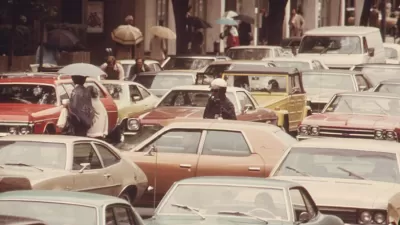Crime
New Report Challenges 'Eyes on the Street' Concept
In the fifty years since Jane Jacobs introduced the "eyes on the street" theory, it's become a commonly accepted conceit that a mix of use reduces crime. A new study calls that theory into question.
The case against mixed-use: not proven
A recent study suggesting that mixed-use zoning increases crime is not as persuasive as it might seem at first glance.
Stop Segregating the Rich! Fighting Displacement Fights Crime
Isolating poor residents from rich ones is not only bad for those being segregated, it leads to the worst outcomes for a city as a whole. Fighting displacement results in less crime and more stable and healthy communities.

An Astounding Explanation for Why Big Cities Are More Dangerous Than Small Ones
For decades, researchers have hunted for an explanation for why big cities have been more prone to violent crime than small ones. A new hypothesis may offer a surprising answer, and prove that big cities aren't inherently much more dangerous.

As Cities Become Safer, Crime Decamps for the Suburbs
Homicides are decreasing nationwide, but a federal study reveals that the rate has decreased about 17% in cities and increased by the same rate in suburbs. Two WSJ reporters look behind the numbers for the causes with a focus on Atlanta's suburbs.
Crime: Inner Cities are Beginning to Resemble Suburbs, and Vice Versa
The Economist examines how London's inner city neighborhoods are well past an inflection point in crime rates. In many cases inner city neighborhoods are now safer than suburban neighborhoods and the trend is set to continue.
The Community-Building Power of Communal Gardens
Planted to solve a perceived food desert problem, urban gardens are harvesting more than just fresh, nutritious food. Neighborhoods surrounding gardens are seeing surprising declines in violent crime.
Urban Trees: Friend or Foe to Crime?
A new study published in the June issue of Landscape and Urban Planning intends to settle once and for all the debate about whether urban trees provide a deterrent or inducement for crime, writes Eric Jaffe.
LAPD Moves to Curb "Lawlessness" on Venice Beach
A rising tide of hostility along Venice's famous boardwalk has prompted residents to call on the LAPD for help, Martha Groves reports.
Driving out one Nuisance With Another
The American Society of Landscape Architects examines the implications of squeezing teens out of the public sphere.
Less Crime Through Urban Design
Environmental criminology may not be the most well-known field, but in this profile of Nikki Filipuzzi and her work throughout Calgary, Tamara Gignac shows how even the right amounts of shrubbery and light can make the city safer.
The Most Dangerous Cities in the United States
While many stories have been written about Detroit's turnaround, it took the top spot on Forbes list of most dangerous cities. Detroit had 1,111 violent crimes reported per 100,000 residents, which included 345 murders, writes John Giuffo.
Tenderloin National Forest
An unconventional outdoor spaces has helped transform a small part of a problem-riddled San Francisco neighborhood.
Crime Dropping in Urban Areas
Crime in urban areas is on the decline. Some attribute the drop to increases in the amount of people returning to city centers.
Philadelphia Tries to Crack Down on Youth Mobs
In the face of recent violence committed by roaming groups of teenagers, officials in Philadelphia are imposing stricter curfews for youth.
Cities, Riots and Facial Recognition Technology
As riots engulf London, the role of technology in cities and crime-fighting comes into the spotlight. Some wonder whether this could usher in the age of facial recognition in cities.
Suburbs or Cities: Which Has More Crime?
A Brookings Institute report shows that the difference between crime in the suburbs and cities has drastically decreased, and argues that the current drop in crime rates weakens the correlation between ethnic groups and crime.
Drug War Leaves Wake of Empty Homes
The border city of Juarez, Mexico, has been a flashpoint in the drug-fueled violence that has plagued many parts of Mexico. Recent figures show that nearly 25% of the homes there have been abandoned.
Data and Maps Aiding Police
Geomapping data is helping police in cities address problem areas, improve unsafe intersections and improve overall efficiency.
Megacity to Install 500,000 Security Cameras
The Chinese megacity of Chongqing has announced plans to install a half a million surveillance cameras by 2012.
Pagination
Urban Design for Planners 1: Software Tools
This six-course series explores essential urban design concepts using open source software and equips planners with the tools they need to participate fully in the urban design process.
Planning for Universal Design
Learn the tools for implementing Universal Design in planning regulations.
Caltrans
Smith Gee Studio
Institute for Housing and Urban Development Studies (IHS)
City of Grandview
Harvard GSD Executive Education
Toledo-Lucas County Plan Commissions
Salt Lake City
NYU Wagner Graduate School of Public Service


































